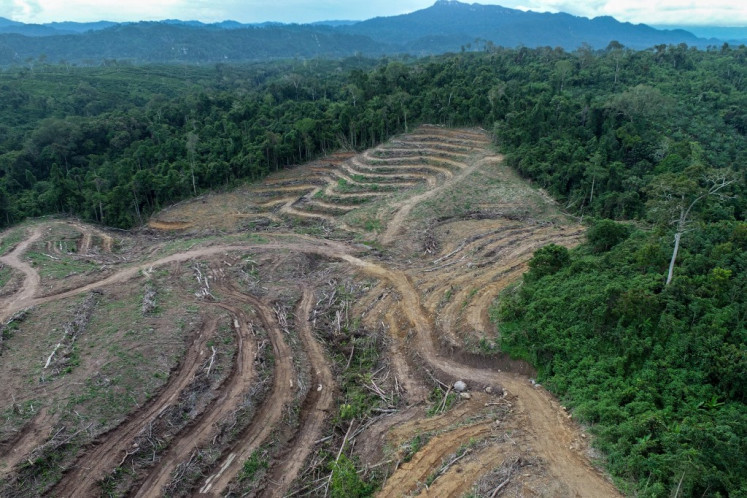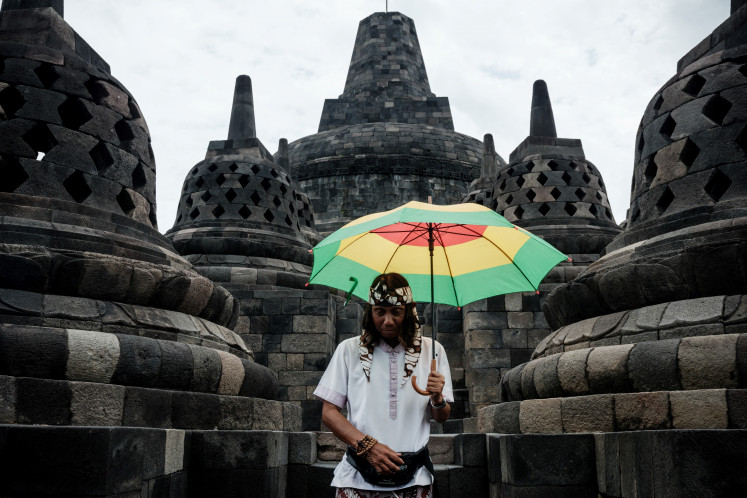Popular Reads
Top Results
Can't find what you're looking for?
View all search resultsPopular Reads
Top Results
Can't find what you're looking for?
View all search resultsKauman & Laweyan, Surakarta's batik and heritage centers
Skilled hands: Two women work on hand-drawn batik clothes at the Gunawan Setyawan batik house in Kampung Kauman
Change text size
Gift Premium Articles
to Anyone
Skilled hands: Two women work on hand-drawn batik clothes at the Gunawan Setyawan batik house in Kampung Kauman.
Surakarta in Central Java has long been known as a center for batik craftsmanship, being the royal seat of the Pakubuwono dynasty. After years of neglect caused by the onslaught of factory-made batik prints, Surakarta is revitalizing its batik-making centers.
For more than 200 years Surakarta, Central Java, has had two special districts, Kampung Laweyan and Kampung Kauman, which are well known not only for their age, but also for their historic batik industries.
Formerly, the two areas enjoyed a heyday as batik trading centers. However, both neighborhoods ceased their activities as handmade and printed batik fabrics were overwhelmed by modern batik products from China.
The dark period lasted from the 1980s until 2004, when the city's batik industry entered its revival. Today, after more than 10 years, batik has turned Kauman and Laweyan into popular shopping and tourist destinations.
'Kampung Laweyan tends to serve as an educational tourist spot, where visitors mostly observe the district and learn how to make batik designs,' the chairman of the Kampung Laweyan Development Forum (FPKBL), Alpha Fabela, said.
In the early period of Joko 'Jokowi' Widodo serving as Surakarta mayor in 2005, the city administration was actually already developing Laweyan as a batik center and as a cultural heritage zone.
Icon: A batik maker sits above a street corner as the icon of Kampung Kauman in Surakarta. Kauman and Laweyan are two main centers of batik making in the city.
The 24-hectare zone has various heritage buildings that have a unique blend of Javanese, European, Chinese and Islamic architectural features surrounded by tall fences. Laweyan's narrow alleys are where the houses of batik makers of the early 20th century can be found.
Therefore, the development of Laweyan as a batik district is directed toward the creation of a home-gallery atmosphere. 'The old buildings are revived not only as residences, but also as batik production houses and galleries,' said Surakarta Culture and Tourism Agency chief Eny Tyasni.
Through a tourism package, visitors are taken around to inspect the historic traces of Laweyan's batik industry from the 1900s. This package includes homestay facilities and practicing handmade and printed batik making.
Kampung Laweyan also offers other historic sites, such as the tomb of Kyai Ageng Henis (an ancestor of the Mataram kings), the house of Kyai Ageng Henis and Sutowijoyo (or Panembahan Senopati, founder of the Mataram kingdom) and the house and museum of H. Samanhudi, founder of the Islamic Trade Union (SDI).
'We're conserving 30 historic buildings in Laweyan to support the promotion of heritage tourism. The budget is provided by the Public Works and Public Housing Ministry and the city administration,' revealed Eny.
As a tourism zone, Alpha said the city administration had not yet supplied Laweyan with supporting infrastructure like guideposts, transportation access and parking facilities.
'The Batik Solo Trans [BST] route that should pass Kampung Laweyan has no transportation access yet,' he remarked.
Kauman, the other batik center in Surakarta located not far from the main road, Jl. Slamet Riyadi, has maintained the tradition because of the many abdi dalem (royal servant) batik makers of the Keraton Surakarta (Sultanate Palace) living in the district.
While Laweyan produces a lot more modern-styled batik, Kampung Kauman mostly turns out batik with classic motifs based on palace standards by using silk material.
Apart from batik, Kampung Kauman also boasts historic structures such as the joglo (traditional Javanese) mansions, limasan (pyramidal) houses, colonial buildings and Javanese-Dutch architectural constructions.
'Tourism in Kauman is combined with the Laweyan package because both share heritage and batik characteristics. We've built city walk facilities on Jl. Slamet Riyadi for easier access to Kauman,' added Eny.
Stamped: A man stamps a batik motif on a piece of cloth in Kampung Laweyan.
A batik entrepreneur in Kauman, Gunawan Setiawan, said that through the Association of the Kauman Batik Tourism Village (PKWBK) Kauman residents had been sharing responsibilities with the Surakarta city administration.
'The city government takes care of the district's reordering while residents create Kauman's brand as a batik and heritage village,' he indicated. The branding is achieved through batik events like Batik Day and free batik-making workshops for students.
'At present we're promoting Kampung Kauman as a religious, historic, educational and shopping tourism spot. Kauman's proximity to the palace, the Grand Mosque and Pasar Klewer enables it to offer an appealing variety tourism package,' added Gunawan.
' Photos by JP/Ganug Nugroho Adi












